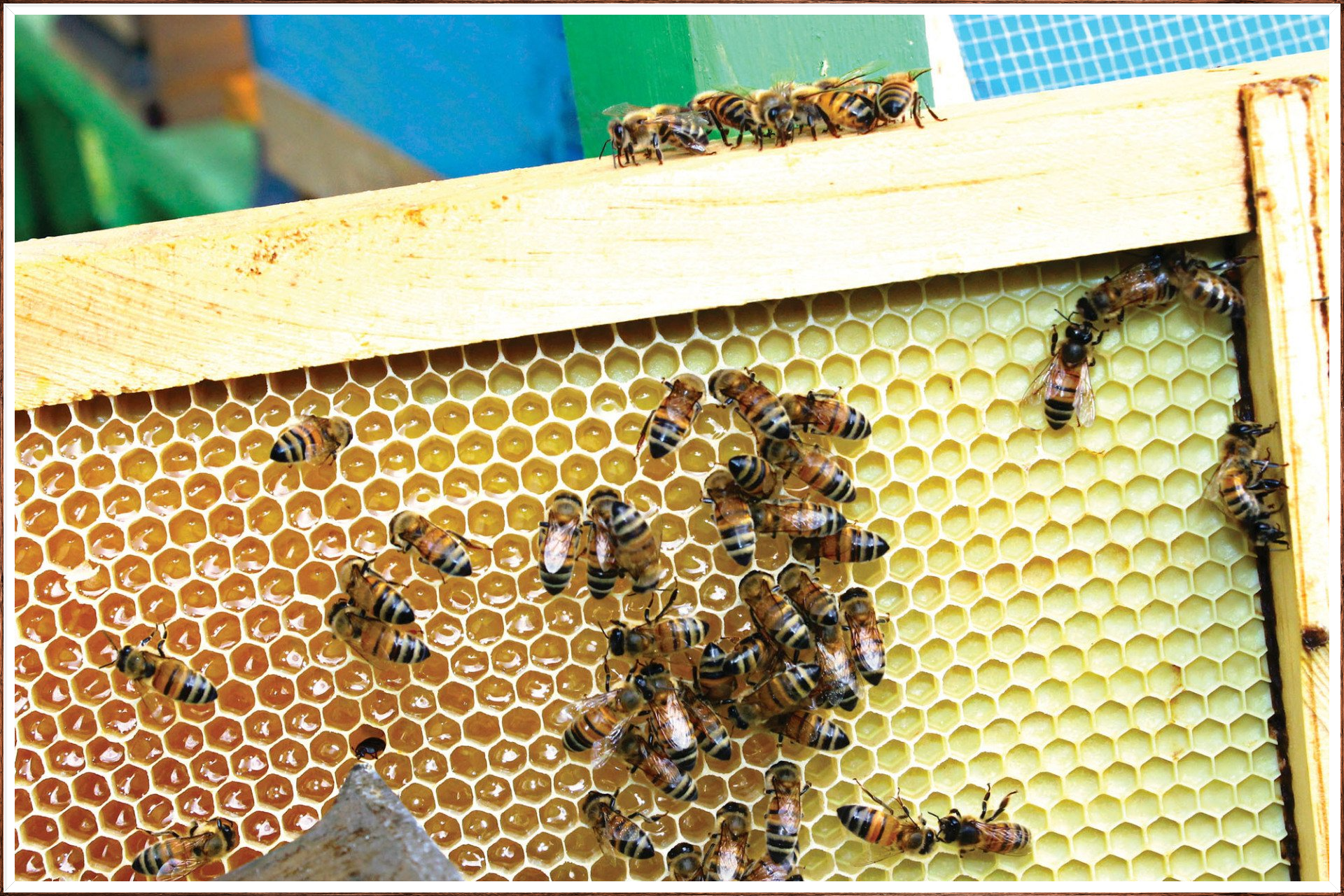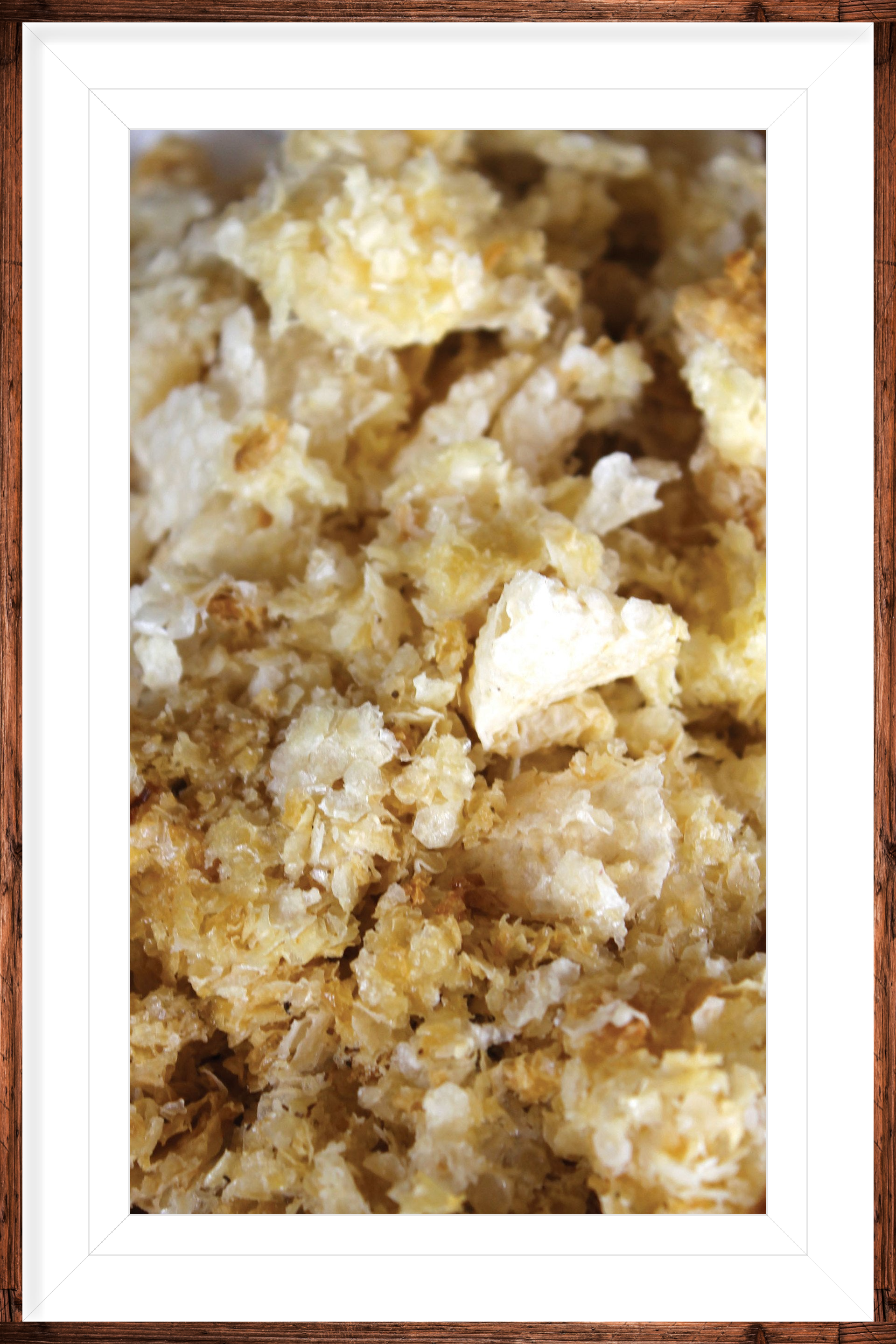Gervais started her hobby in an effort to help pollinators, and thereby helping the environment.
“Anything I can do to help the outcome,” she said. “I also love honey. It’s a hobby and occupies my time. It’s a byproduct of my love for gardening.”
But the hobby has several side benefits, in the form of the golden liquid treasure it yields, and the beeswax that can be used for a multitude of purposes.
“In addition to candles, I make a food-grade wax to waterproof cooking utensils we use for grilling. I also make a waterproof for boots, pants and winter coats.”
The bee community is highly structured and organized, with each of the three types of bees having a single purpose.
“First there is the queen,” Gervais said. “You know when a queen is about to hatch because she will make a trumpeting sound that is audible throughout the hive and even outside.”
Trumpeting occurs when there is more than one queen in a hive, and it signals that a virgin is ready to fight for the honor of being the one-and-only. During swarm season, workers hearing the sound may try to keep the virgins separate in order to have more than one queen available in case she’s needed.
“Once she hatches, she makes a three-day virgin flight,” Gervais said. “She will mate with 12 to 15 drones and return to the hive, never leaving it again. Her job, for the rest of her life, is to lay eggs in the hive.”
“Beekeepers can also remove the frame that contains the unhatched queen cell and place it in a nuc,” Gervais said. “It has between two to five frames and they are taken from the nuc and placed directly into a new hive. When apple trees start blooming, that’s the time to start looking for queen cells, and when you should split the hive. That gives it time to become established, build their combs and collect pollen and nectar. You won’t harvest off the new hive for the first year.”
In a five-frame configuration, three frames contain brood of all stages, while the outer two frames normally store honey and pollen. Queens can lay approximately 20,000 eggs per day, keeping the other workers of the hive busy.
“Drones are the next type of bee,” Gervais said. “Their entire life is spent making babies and eating.”
Drones in a hive do not usually mate with the virgin queen of the same hive. Doing so could weaken the genetics of the hive.
“The third type of bee is the worker bee,” Gervais said. “They fall into two categories; nurse bees that clear out all of the old cells in the honeycomb, like housekeeping, and they feed the queen, and pollinators, that search out the food sources and brings them back to the hive. They drop off nectar and pollen, and the nurse bees will determine where in the hive it is needed.”
Drones die off or are ejected from the hive by the worker bees in late autumn, dying from exposure and the inability to protect or feed themselves.
“The worker bees evict them,” Gervais said. “The drones could completely deplete the hive’s stores for the winter while contributing nothing to the survival of the colony.”
Bees have truly remarkable capabilities, including insulating their hives for winter using a wax they create called propolis, which is a resinous mixture that honey bees produce by mixing saliva and beeswax with saps, gums, latex, and resin gathered from tree buds, sap flows or other botanical sources. It is used as a sealant for unwanted open spaces in the hive.
“It’s very strong,” Gervais said. “By doing that, they can better control the temperature in the hive. Propolis is anti-bacterial and anti-microbial, the bees use it against pathogenic microorganisms that could threaten the hive’s health and survival.
“Bees can also cool the hive when temperatures are too hot,” Gervais said. “It’s called bearding, You will find the bees fanning their wings as a group. It is how bees cool the inside of the hive and also how they evaporate some of the moisture from the honey.”
Bees can also bring in water from outside sources and fan their wings across a droplet of water to help cool the hive.
Hives can hold between 20,000 and 100,000 active, working bees, depending on the amount of space that is available.
Placement of the hives is also an important factor.
“Mine are in a draw, so they don’t get as much wind,” Gervais said. “My husband also built a “bee-zebo,” which protects the hives from direct sunlight and rain. If the hives are not sealed well, they can drown. They get the morning sun, so they can get up early and start working.”
Gervais finds one of the most satisfying aspects of beekeeping is seeing the pollinators return to the hive wearing “little yellow pantaloons.”
“That is the collected pollen,” she said. “They enter the hive at the bottom and go all the way to the top, where a nurse bee will direct it to the location of the cell to deposit the pollen. Once that cell is full, it is capped off. Later, the nurse bees will feed it to the brood.”
Plant nectar is also stored in the cells. Bees collect the plant nectar and when stored within their stomachs is passed from one worker to the next until the water within it diminishes. At this point, the nectar becomes unripe honey, which workers store in the honeycomb cells.
As for Gervais, she typically places two “supers” above the brood box.
“That’s where the honey is stored. The brood comb is usually found in the lower part of the beehive. Once the bees have filled the deep hive bodies with enough honey to sustain the colony, they will begin to make honey in the super.”
And that precious, golden treasure is what Gervais harvests at summer’s end.
“I love canning pears and honey together for pear honey jam,” she said. “It’s my mother’s recipe, and it’s a real treat.”
She also bottles honey to distribute to family and friends.
“A lot of people take honey as a way to become immune to allergies,” she said. “My recommendation is to take honey harvested in the season they are suffering allergies the worst. Those are the blooms used to make that honey.”
The benefits of using honey are nearly endless, and include treating burns, soothing sore throats, improve memory function, as a sugar substitute for diabetics, fertility boosters for men and women, and a dressing for wounds and ulcers.
Gervais enjoys her interactions with the bees.
“Anytime I go in there, there are a lot more flying around me, wanting to know who I am and what I’m doing,” she said. “After awhile, they get to know me.”
Gervais said she has plans to establish two or three additional hives on another part of the 40-acre spread where she and her husband reside.
“We have plenty of room,” she said. “And locating new hives in a different area, they won’t be competing for resources.”
Those wanting to explore the options of beekeeping may find more information through Southern Missouri Beekeepers of Monett, or by calling Kevin Young at
417-847-5464.












